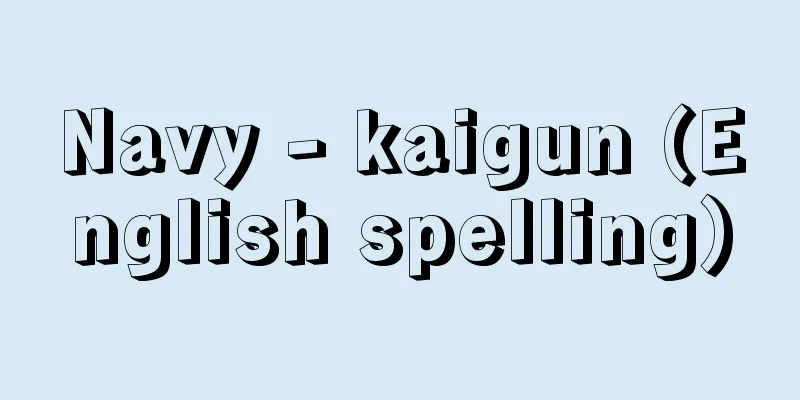Navy - kaigun (English spelling)

|
The term refers to the military force possessed by a nation, whose main purpose is to prevent invasions from the sea and maintain control over the oceans. Humans are creatures of land, but two-thirds of the Earth's surface is covered by water. As the sphere of life expanded, the battlefield of war also spread from the rivers that were the birth place of civilization to the seas, and in the process, the navy was born, with the surface of the water as the battlefield. For a long time, the exercise of power was dependent on coastal and wind power, but in the 19th century, the introduction of propulsion engines enabled free operation across the entire ocean, and with the advent of submarines and aircraft, the navy's field of action expanded to three-dimensional areas that included not only the surface but also underwater and air. Technological advances have also marked a major turning point in naval tactics. Naval battles from ancient times to the Middle Ages were nothing more than an "extension of land warfare" on the coast, with armed soldiers boarding wooden sailing ships, ramming enemy ships to bring them alongside, and then stepping inside the ships. With the dawn of the Age of Discovery, the discovery of the New World, the voyage to the ocean, and the founding of colonies began. Sailing warships with cannons lined up on their sides became the main players in naval battles, and naval battles, in which battles were decided by gunfire while fleets moved in a line or in a column, became the norm. Later, with the advent of the Industrial Revolution and the appearance of steel, steam engines, and swivel guns, the style of naval battles and naval warfare underwent a revolutionary change, and the goal of the navies of the world's nations became to gain control of the seas through fleet battles centered on battleships. Furthermore, in modern navies after World War II, with the development of unlimited cruising capacity of nuclear-powered ships and various missiles, including SLBMs (Submarine-Launched Ballistic Missiles) that can launch nuclear attacks from the sea to any point in the world, the use of nuclear weapons is no longer limited to controlling the seas, and the boundary between land and sea is rapidly disappearing. [Tetsuo Maeda] Naval HistoryAncient navies and naval warfareNavy appeared with the emergence of nations and the development of civilization. It was first witnessed in the Mediterranean world. Around 2000 BC, the Egyptian kingdom had many warships on the Nile. The scene of the battle in 1192 BC during the reign of Ramses III against the Philistines and the Zacharians at the mouth of the Nile is preserved for posterity in the bas-reliefs of Medine Abu, which show that the Egyptian kingdom already possessed warships equipped with many oars and large square sails. However, Egyptian warships did not venture beyond the Nile, so it was the Phoenicians who first dominated the Mediterranean. From around 1500 BC until their downfall by Alexander the Great in 332 BC, they were the first seafaring people and trading city-states in history, and not only sailed throughout the Mediterranean, but even circumnavigated Africa by crossing the Strait of Gibraltar. The Phoenicians built three kinds of ships, one of which was the war galley, which had a ram on its bow and was manned by warriors with their shields propped up on the sides of two rows of oarsmen. Famous ancient naval battles include the Battle of Salamis (480 BC) between Greece and Persia, and the Battle of Actium (31 BC) between Octavian and the allied forces of Antony and Cleopatra, which occurred after the collapse of the Roman triumvirate. The Battle of Salamis was the decisive battle in a long war that Persia, which had become a powerful empire under Darius I, launched in an attempt to conquer Greece, the ruler of the Aegean Sea. The Persian army led by Darius I's son Xerxes I defeated the Greek army in the Battle of Thermopylae and took the Acropolis, and attempted to achieve a final victory by destroying the Greek fleet waiting on Salamis, a small island near the western coast of Attica, Greece. The Greek fleet of 310-380 galleys and the Persian fleet of 450-600 galleys collided in a narrow bay and engaged in a battle using rams and bows and arrows, resulting in Xerxes I suffering devastating damage and retreating. This naval battle caused Persia to give up on the conquest of Greece, and Athens' prosperity flourished thereafter. The Battle of Salamis was also the first demonstration of the theory of naval supremacy, which states that even a powerful land power cannot control a small maritime nation unless it wins a naval battle. The Battle of Actium, on the other hand, was a naval battle fought off the coast of Actium in the Ionian Sea after Caesar's death, between Caesar's adopted son Octavian and Caesar's subordinate Antony, who was captivated by the charms of the Egyptian queen Cleopatra, with a total of nearly 500 warships from both sides. The defeat of the Antony-Cleopatra coalition led to the downfall of the Egyptian Kingdom and the establishment of the Roman Empire. [Tetsuo Maeda] Medieval navies and naval warfareIn the Middle Ages, the invention of gunpowder and the practical application of cannons allowed the scale of naval battles to expand (although they were still battles on land on ships). The naval battle of 1571 off the coast of Lepanto in Greece between the Ottoman Turks and the anti-Turkish Holy League (Venice, Genoa, Spain, the Pope, and Malta) was the last large-scale battle between galley fleets. The Ottoman Turks lost this battle, and although they still boasted the strongest land force, they were no longer able to advance into Europe. The significance of this battle in Europe can also be seen in the fact that Pope Pius V made October 7 an eternal holiday to celebrate the victory. After Lepanto, the purpose of navies and the nature of naval battles changed with the advent of the Age of Discovery to a battle between European powers for colonies in the New World. The area of operation expanded from the Mediterranean to the Atlantic, Caribbean and Indian Oceans, and European empires built ocean-going fleets to control the sea routes essential to maintaining their colonies. Through battles between the Spanish Armada and the Royal Navy (1588, the Royal Navy won), and three naval battles between Britain and the Netherlands (1652-1673, the Royal Navy prevailed), Britain and France came to compete for maritime power in the 18th century. The culmination of this was the Battle of Trafalgar (1805), when Napoleon, riding on the momentum of his conquest of continental Europe, challenged Britain's maritime dominance, but the British fleet under Nelson completely defeated the French fleet off the coast of Trafalgar in Spain, thwarting Napoleon's plans to invade Britain and establishing the path to Britain as a maritime empire on which the sun never sets. The main players in this battle were ships of the line, three-masted, three-deck gun decked wooden ships that had reached their limit of development. 27 British ships and 33 French and Spanish combined fleets participated in the battle. Nelson's Victory had a displacement of about 3,500 tons, 104 guns on each side, and a crew of over 800. Its tactics were not based on ramming or slashing, but on gunfire, and the deciding factors in the battle were the skill of the fleet's dispersion and concentration, as well as the speed and accuracy of their firing, under orders issued by signal flags. [Tetsuo Maeda] The era of big ships and big gunsAfter the Battle of Trafalgar, naval history moved from the age of sailing ships to the age of steel ships and steamships. A. T. Mahan, president of the U.S. Naval War College, who studied naval history up to this time, presented his theory of naval supremacy in his book The Influence of Sea Power on History, 1660-1783 (published in 1890), which states that sea power established by naval strength is the determining factor of world domination, and this theory had a major impact on the naval policies and shipbuilding plans of various countries. Then, in the midst of the Russo-Japanese War in 1905 (Meiji 38), the Battle of Tsushima, the largest modern naval battle, occurred, and the Japanese fleet achieved a Trafalgar-like victory over the Russian fleet. Following this living example and Mahan's doctrine, the various nations began to compete with each other in building fleets of large ships and large guns. When Britain built the battleship Dreadnought (1906), which had a 12-inch gun and a speed of 21 knots, the era of giant ships and super giant ships was ushered in, and a fierce naval arms race unfolded between Britain, the United States, and Japan. However, naval battles in World War I were determined more by the outcome of the Battle of Jutland (1916), in which battleships with large guns fought each other, than by Germany's unrestricted submarine warfare. The newly emerging naval power Germany decided that it had no chance of defeating Britain in surface battles mainly using battleships, and turned its attention to the submarine, a new weapon at the time, and used U-boats to carry out commerce raiding and guerrilla activities at sea. With the advent of submarines, naval battles expanded into two dimensions, above and below the surface, and became more all-out, unwarned, and unrestricted, with neutral ships and merchant ships also being targeted for sinking. Germany's unrestricted submarine warfare achieved 423 ships and 849,000 tons of firepower in one month (April 1917), but it also led to the neutral United States entering the war in anger at this tactic, and was the beginning of the defeat of the German Empire. The naval arms race, which ignored national power, was resolved by two conferences held after World War I (the Washington Naval Conference in 1921-1922 and the London Naval Conference in 1930) aimed at limiting naval armaments, limiting the ratio of capital ships possessed by the UK, the US, Japan, France, and Italy to 5:5:3:1.75:1.75, and limiting Japan's total share of auxiliary vessels (cruisers, submarines, etc.) to 6.97% of that of the US. However, these treaties did not end the expansion of the navy. In Japan in particular, these two disarmament conferences created animosity within the navy, as the fleet faction, which distrusted the treaty, began to oppose the moderate treaty faction, and the sense of inferiority caused by the "imposed London Treaty" led to the construction of huge battleships such as the Yamato and Musashi when it expired at the end of 1936 (Showa 11). In response, the United States also implemented a large-scale shipbuilding policy in anticipation of a war against Japan, and the Pacific Ocean, the largest ocean, came to be recognized as a decisive battleground between the Japanese and American navies. [Tetsuo Maeda] World War IIWorld War II was an unprecedented war in the sense that the naval battles spread to all the major sea areas of the world, and that the battlefield expanded to the air, becoming three-dimensional and high-speed. Japan and Germany, whose battlefields were torn apart between the ocean and the continent, were defeated, while Britain, which managed to defend its sea lanes, and the United States, which left its own country outside the battlefield and developed the transoceanic transport capacity of many ships, aircraft, and military supplies, emerged as the winners of the naval battles of the world war. However, this war did not develop into the fleet battle between large ships and huge guns that the naval authorities had anticipated in advance. In the Atlantic, as in World War I, the focus was on the German Navy's U-boats against the Allied forces' anti-submarine operations and convoy escort, and the German submarine fleet sank 2,828 Allied and neutral ships, totaling 14.68 million tons, throughout the war, but lost 781 U-boats itself, and was forced to fight a battle without compensation, sinking 1.5 U-boats for every merchant ship it sank, leading to its defeat at the end of the war. Meanwhile, in the Pacific Theater, the US Navy's aircraft carrier task force and amphibious warfare capabilities dragged the Japanese Navy's battleship-based battle fleet into a war of attrition consisting of air superiority and island capture, and defeated it. In particular, the battle method that became standard after the Battle of Guadalcanal - the battle for island bases, construction of air bases, acquisition of air superiority, acquisition of sea superiority, and advancement of the front line - and the large number of amphibious ships (typically LSTs, or landing craft such as tank landing ships) that were built to suit this, played a key role in the Pacific Theater along with aircraft. Thus, from the perspective of naval warfare, the First and Second World Wars marked a break with the long naval tradition that had continued since the Battle of Salamis of deciding wars through decisive battles between warships at sea, and while fleets had reached their greatest size, they were used in a variety of wars that reduced their independence and uniqueness, such as convoy escort and anti-submarine operations, transoceanic invasions, amphibious warfare, and combined operations with other arms of the military, as typified by the Normandy landings and the Battle of Okinawa. The era in which the navy and the ocean were one world in themselves came to an end. [Tetsuo Maeda] History of the Japanese NavyDuring the Edo period, national defense was based on a policy of isolation and segregation through a strict national isolation policy, and for over 200 years since the Edo period, Japan did not have a military force known as a navy. However, in the 19th century, when warships from Western countries began to appear in Japan demanding the country's opening up, calls for the creation of a navy suddenly grew louder. Pioneers of the theory of maritime defense include Hayashi Shihei, Sakuma Shozan, Yokoi Shonan, and Sakamoto Ryoma. In 1855 (Ansei 2), two years after the arrival of Perry's fleet, the shogunate established the Naval Training School in Nagasaki, and, modeled on the Dutch Navy, began training in navigation, naval architecture, gunnery, and other subjects. Talented personnel such as Katsu Kaishu (first Lord of the Admiralty), Kawamura Sumiyoshi (second Lord of the Admiralty), Enomoto Takeaki (third Lord of the Admiralty), and Nakamuda Kuranosuke (first Chief of the Naval General Staff) graduated from the school. In 1860 (Man'en 1), the Kanrin Maru, commanded by Katsu Kaishu, crossed the Pacific Ocean and sailed to America, laying the foundations of the modern navy. After the Meiji Restoration, the new government established the position of Governor-General of the Navy and Army within the Dajokan government system and began developing the navy, implementing a national defense policy that placed the navy first and the army second, with the Naval Training School (later the Naval Academy) completed in Tsukiji, Tokyo in 1869 (Meiji 2), and the Yokosuka Shipyards (later the Naval Arsenal) completed in 1871. In 1868, the first naval review was held off the coast of Tempozan, Osaka, and only six ships with a total displacement of just 2,450 tons took part, but by 1878 the Japanese had grown to the point where they completed the domestically made steel ship Seiki (898 tons) and made the first long-distance voyage to European countries. The founding of the Meiji Navy coincided with a period of technological change in world history, when wooden sailing ships were replaced by powered steel ships. As such, the Japanese Navy was under roughly the same conditions as other nations, and taking advantage of the times, it quickly rose to prominence among the navies of the world. In both the Sino-Japanese and Russo-Japanese wars, the Navy's activities in both sea control and transportation contributed greatly. In preparation for these two wars, the Japanese Navy established a modern fleet organization consisting of a standing fleet and a combined fleet, and at the same time, it made the command position, which had previously been under the Chief of the Army General Staff, equal to that of the Army. After defeating the navies of the Qing and Russian dynasties, the hypothetical enemy came to be depicted as the US Navy, and the anticipated battlefield was a fleet battle in the Western Pacific. From the Taisho to the early Showa era, Japan enjoyed the status of being one of the world's "three great naval powers." This was the peak of the era of large ships and large guns, as represented by the battleships Nagato and Yamato. However, while Japan sought balance with the U.S. Navy, relations with the U.S. deteriorated due to the Army's policy of expanding into the continent, and Japan was forced to face the massive expansion of the U.S. Navy, which was superior to Japan in national power. The surprise attack on Pearl Harbor in December 1941 was a strategy to reverse the naval power of Japan and the U.S., but it ultimately aligned American national opinion with the war against Japan and encouraged the formation of a fleet centered on aircraft carriers, so the opportunity for a fleet battle in the Pacific, which the Japanese Navy had been nurturing for many years, never arrived. The war situation was centered on the acquisition of air superiority by the aircraft carrier task force and the battle for island bases in the South and Central Pacific, and after more than three years of fighting, the Japanese Navy was destroyed. [Tetsuo Maeda] Modern NavyAfter the Second World War, the navy underwent a major change in its purpose and mission due to the power revolution, which saw the development of nuclear propulsion engines and the ability to obtain desired cruising range, and the tactical revolution, which saw the emergence of nuclear weapons and their delivery means shifting the main area of activity to the ocean. The symbol of naval power also shifted from battleships to aircraft carriers, and then to nuclear submarines equipped with strategic missiles. Under the nuclear deterrence strategy, the target of attack by strategic nuclear submarines equipped with nuclear ballistic missiles was set not on the enemy navy but on the strategic destruction of the enemy's political and military center. As a result, a fundamental change was brought about in the modern navy, from the time when the classical mission of the navy was "to destroy the enemy fleet" and "to secure control of the sea," to "to control the land from the sea." During the Cold War, the US and Soviet navies commissioned 34 and 80 (in the 1980s) ballistic missile submarines, respectively, which constantly patrolled the other country's important land bases within range from the sea. The number of strategic nuclear warheads possessed by each country reached 9,665 for the US and 8,880 for the USSR during this period, of which 5.3% were loaded onto strategic submarines by the US and 2.6% were deployed at sea by the Soviet Union. This fact shows that the relationship between the sea and the navy has fundamentally changed in the nuclear age. The navies during the Cold War were reorganized into East and West camps, centered on the strategic nuclear weapons that had been moved to the sea, and therefore on the activities of the US and Soviet navies, which were nuclear powers. The Royal Navy, which once claimed dominance over the seven seas, became merely a local power in the Atlantic. The missions of the U.S. Navy in the nuclear age were (1) strategic deterrence against the Soviet Union, (2) control of the seas, (3) projecting forces on land, and (4) demonstrating presence, with the primary mission being the maintenance of "deterrence and balance" and, if deterrence was broken, strategic destruction within the enemy's country. On the other hand, as stated by Admiral Gorshkov, Commander-in-Chief of the Navy, in his book "The Maritime Power of the Nation," published in 1976, the Soviet side also listed the Navy's main mission as "the destruction of the enemy's strategic targets on land with strategic missile submarines," with nuclear retaliatory power against land at the top of the list. The US-Soviet rivalry over ocean nuclear weapons reached its peak in the 1980s. The US Navy's strategic nuclear submarine Ohio (submerged displacement 18,700 tons), the first of which was commissioned in November 1981, housed 24 Trident I C-4 submarine-launched ballistic missiles with a range of 7,400 km. Each missile was equipped with a MIRV (multiple individually guided revolving warhead), giving it the ability to launch nuclear attacks on up to 192 land targets. In contrast, the Soviet Union developed the Typhoon-class strategic nuclear submarine with a submerged displacement of 25,000 tons and 20 missile launchers, which was estimated to be capable of launching nuclear attacks on the US mainland from underwater in its own waters or under the ice in the Arctic Ocean, 8,300 km away. In this way, during the Cold War, the main focus of nuclear deterrence strategy was transferred to strategic submarines with high survivability (initially strategic bombers, then land-launched ICBMs), and the US and Soviet navies came to possess enormous destructive power as the central military force in national security, but this was due to their role in carrying out a nuclear deterrence strategy, which was completely different from that of conventional navies. Not only the US and Soviet navies, but also the British and French navies, which possessed a small number of strategic nuclear submarines, underwent a similar shift in missions. China, after acquiring nuclear weapons, also loaded some of them onto submarines and moved them to the ocean, so all the navies of nuclear-armed countries became the carriers of the nuclear deterrence strategy. With the end of the Cold War and the dissolution of the Soviet Union, the US Navy remained as the maritime master in the final period of the 20th century. It is true that a period of relaxation has come in the maritime competition for dominance over nuclear deterrence strategies, but with no end in sight for nuclear disarmament, the role of the ocean and navies as launch sites for vast nuclear weapons has not yet ended. On the other hand, the rapid increase in sovereign states that characterized international relations after the Second World War and the accompanying maritime nationalism, i.e. the trend toward expanding maritime sovereignty as seen in the expansion of territorial waters (from 3 to 12 nautical miles) and the establishment of exclusive economic zones (200 nautical miles), also provided an opportunity for small and medium-sized countries and the navies of the Third World to take on new challenges. At the same time, the emergence of jet-propelled and rocket-propelled ship-based missiles heralded the arrival of a new era in naval tactics that replaced the old big ships and big guns. In October 1967, in the midst of the Third Arab-Israeli War, a small Egyptian patrol boat sank the Israeli destroyer Eilat (2,300 tons) using the Soviet-supplied anti-ship missile Styx (SS-N-2), which sent a huge shock through the navies of various countries, marking the beginning of the era of missile navies. In the 1982 Falklands War, Argentina, who was initially thought to be at a disadvantage, shocked the world by using the anti-ship missile "Exocet" (made in France) to sink three ships, including the British destroyer "Sheffield" (4,100 tons), from the air beyond the horizon. It is said that four of the six "Exocet" missiles used hit their targets. This fact raised serious doubts about the survivability of large surface ships such as aircraft carriers, and also taught the lesson that even small and medium-sized countries can compete with the navies of major powers by equipping them with small, inexpensive, and easy-to-operate PGMs (precision-guided munitions). From a long-term perspective, the arrival of an era in which surface ships become prey to missiles seems inevitable. Therefore, it can be said that the position of the Navy in the 21st century is facing a turning point on two fronts: on the one hand, the uniqueness of maritime strategy is being lost as a result of the longer range of nuclear missiles and the relocation of launch bases underwater, and on the other hand, the decisive advantage of great powers over small and medium-sized countries, which had previously been negligible, is also beginning to crumble. [Tetsuo Maeda] "American Classics Library 8: Alfred T. Mahan" translated and annotated by Sadao Asada (1977, Kenkyusha)" ▽ "Western European Naval Warfare History: From Salamis to Trafalgar" by Saburo Toyama (1981, Hara Shobo)" ▽ "The Navy and Japan" by Kiyoshi Ikeda (Chuko Shinsho) [References] | | | | | | |Source: Shogakukan Encyclopedia Nipponica About Encyclopedia Nipponica Information | Legend |
|
国家が保有する軍事力のうち、おもに海からの侵略阻止や海洋支配の維持を目的とする軍種をいう。人間は陸の生物であるが、一方、地球表面の3分の2は水に覆われている。戦争の場も、生活圏が拡大するにつれ、文明の母胎である川のほとりから海へと広がっていき、その過程で水面を戦闘空間とする海軍が生まれた。長い間、その力の行使の場は沿岸と風力に依存していたが、19世紀、動力推進機関が導入されると全海洋に及ぶ自在な活動が可能となり、さらに潜水艦や航空機の出現によって海軍の行動領域は、水上はもとより水中、空中を含む立体的なものへと拡大された。技術の進展により海軍戦術にも大きな区切りがある。古代から中世にかけての海戦は、木造帆船に武装した兵士を乗り込ませ、敵船に衝角(しょうかく)を突き当てて接舷(せつげん)させたあと船内に踏み込んでゆく、沿岸における「陸戦の延長」の域を出なかった。大航海時代の幕開きによって新大陸の発見、大洋への航海、植民地建設の時代が始まると、舷側に大砲を並べた帆走軍艦が海軍の主役となり、単横陣や単縦陣などの艦隊運動を行いながら砲戦の応酬で決着をつける海戦が一般的形態となった。その後、産業革命が鋼鉄、蒸気機関、旋回砲を出現させる時代の到来とともに、海軍と海戦の様式も革命的変化を遂げ、戦艦を主力とする艦隊決戦によって海洋そのものの支配を目ざす制海権獲得が列国海軍の目標となる。さらに第二次世界大戦以後の現代海軍においては、原子力推進艦艇による無制限の航続力や、海中から世界のどの地点をも核攻撃できるSLBM(潜水艦発射弾道ミサイル)はじめ各種ミサイルの開発により、その用法は海上支配のみに止まらなくなり、陸と海の境界が急速に失われつつある。 [前田哲男] 海軍の歴史古代の海軍と海戦海軍は国家の出現、文明の発達とともに姿を現した。最初にそれが目撃できるのは地中海世界においてである。紀元前2000年ごろのエジプト王国は多数の軍船をナイル川に浮かべていた。前1192年ラムセス3世の時代にペリシテ人とザカルス人をナイル河口に迎え撃った戦闘の様相は、メディネ・アブの薄浮彫りによって後世に残されているが、この時代エジプト王国がすでに多数の櫂(かい)と大きな角帆を備えた戦闘艦を保有していたことが示されている。しかし、エジプトの軍船はナイル川から出ようとしなかったので、地中海を最初に支配したのはフェニキア人たちであった。彼らは前1500年ごろから前332年アレクサンドロス大王に滅ぼされるまで、史上初の航海民族、通商都市国家として、地中海全域への航海はむろん、ジブラルタル海峡を越えてアフリカ周航さえ成し遂げていた。フェニキア人は3種類の船をつくったが、その一つは戦争用ガレー船で、船首に衝角(しょうかく)をもち、2列に並んだ漕(こ)ぎ手の席の外側に戦士が盾を舷側(げんそく)に立てて乗り組んだ。 古代の海戦として名高いのは、ギリシアとペルシアの間で戦われたサラミスの海戦(前480)、およびローマの三頭政治が破綻(はたん)して起こった、オクタウィアヌス対アントニウス‐クレオパトラ連合軍によるアクティウムの海戦(前31)であろう。サラミスの海戦は、ダリウス1世の手で強大な帝国となったペルシアが、エーゲ海の支配者ギリシアを征服しようとして起こした長い戦争のいわば決戦にあたる戦闘である。ダリウス1世の子クセルクセス1世に率いられたペルシア帝国の大軍は、テルモピレーの戦いにギリシア軍を破りアクロポリスを陥落させ、最後の決をギリシア、アッティカの西方海岸に近い小島サラミス島に待機するギリシア艦隊を撃破することで達成しようと図った。ギリシア海軍310~380隻、ペルシア海軍450~600隻からなるガレー船の艦隊は、狭い湾内で激突して衝角と弓矢による戦闘を展開、クセルクセス1世は壊滅的損害を受けて敗走した。この海戦を契機にペルシアはギリシア征服を断念し、以後アテネの繁栄が花咲くことになる。サラミスの海戦はまた、強力な陸軍大国といえども海戦に勝利を収めない限り小さな海洋国を支配しえない制海権論の初めての実証でもあった。一方アクティウムの海戦は、カエサルの死後、養子オクタウィアヌスと、エジプト女王クレオパトラの魅力のとりことなったカエサルの部下アントニウスとの間で、両軍あわせて500隻近い軍船を動員し、イオニア海アクティウム沖で戦われた海戦である。アントニウス‐クレオパトラ連合軍の敗北によってエジプト王国は滅び帝政ローマが建設された。 [前田哲男] 中世の海軍と海戦中世に入ると、火薬の発明と砲の実用化で海戦の規模は(依然、船上の陸戦であったとはいえ)拡大した。1571年、ギリシアのレパント沖でのオスマン・トルコと反トルコ神聖同盟(ベネチア、ジェノバ、スペイン、教皇、マルタ)間の海戦は、ガレー船艦隊どうしをもってする最後の大規模な戦いであった。オスマン・トルコはこの海戦を失い、なお最強の陸軍国を誇りながらも、以後ヨーロッパに進出することはできなくなった。教皇ピウス5世が、レパントの海戦の勝利を祝って10月7日を永遠の祝日と定めたことにも、この海戦がヨーロッパにもたらした意義の大きさをみることができる。レパント以後の海軍の目的と海戦の性格は、大航海時代の到来とともに、ヨーロッパ強国間における新大陸の植民地の争奪をめぐるものへと変わる。活動海域も地中海から大西洋、カリブ海、インド洋へと拡大し、ヨーロッパの帝国は植民地維持に不可欠な海洋交通路を支配する目的で外洋艦隊を建設して戦った。そのなかでスペイン無敵艦隊(アルマダ)とイギリス海軍の戦い(1588年、イギリス海軍勝利)、イギリスとオランダの3次にわたる海戦(1652~1673年、イギリス海軍優勢)などを経過しながら、18世紀に入ると海上権力はイギリスとフランスによって争われることになる。その頂点をなすのがトラファルガーの海戦(1805)で、ナポレオンが大陸ヨーロッパを征服した勢いをかってイギリスの海上支配力に挑戦したのに対し、ネルソン指揮のイギリス艦隊はフランス艦隊をスペインのトラファルガー沖で完敗させ、ナポレオンのイギリス侵攻計画を挫折(ざせつ)させるとともに、太陽の没することのない海洋帝国イギリスへの道を確立する。この海戦の主役となったのは、戦列艦とよばれる3本マストを帆装し3層の砲甲板をもつ木造船としては極限まで発展した艦で、イギリス27隻、フランス‐スペイン連合艦隊33隻の戦列艦が戦いに加わった。ネルソン座乗の「ビクトリー」は約3500排水トン、両舷に砲104門を積み、800人以上の乗組員を擁した。その戦法も衝角利用や斬(き)り込みではなく砲戦が主体であり、信号旗で発せられる命令の下、艦隊の分散集中能力の巧拙や射撃の速度、正確さが海戦の決め手となっていった。 [前田哲男] 大艦巨砲時代トラファルガーの海戦を最後に、海軍史は帆船時代から鋼鉄船と蒸気船の時代へと移ってゆく。この時期までの海軍の歴史を研究したアメリカ海軍大学校校長A・Tマハンは、海軍力によって打ち立てられたシーパワー(海上権力)こそ世界支配の決定要因だとする制海権理論を、その著書『歴史に及ぼしたシーパワーの影響1660―1783』(邦訳題『海上権力史論』1890年刊)で発表し、各国の海軍政策と建艦計画に大きな影響を与えた。そして1905年(明治38)日露戦争のさなか、近代海戦のもっとも大規模な形としての日本海海戦が起き、日本艦隊がロシア艦隊に対してトラファルガー的な勝利を収めると、列国はこの生きた戦例とマハンの教義に従って大艦巨砲の艦隊整備を競うようになる。イギリスが口径12インチの巨砲と21ノットの速力をもつ戦艦「ドレッドノート」を建造(1906)すると、ド級、超ド級の巨艦時代が現出し、英・米・日3国を軸に激しい建艦競争が展開された。しかし第一次世界大戦における海戦は、大艦巨砲の戦艦どうしが戦ったユトランド沖海戦(1916)の帰趨(きすう)によるより、ドイツの無制限潜水艦戦によって大きく左右された。新興海軍国ドイツは、戦艦主体の水上戦闘ではイギリスに対し勝算はないと判断し、当時新兵器であった潜水艦に着目、Uボートを使って通商破壊戦と海のゲリラ活動を敢行した。潜水艦の出現によって海戦は水上と水中の二次元に拡大され、かつ中立国の船舶や商船をも撃沈の対象とする全面的で無警告・無制限の色合いを濃くするようになった。ドイツの無制限潜水艦戦は1か月間に423隻、84万9000トンの戦果(1917年4月)をあげたが、一方ではこの戦法に憤激した中立国アメリカの参戦を招く結果となり、ドイツ帝国を敗戦へと導く端緒ともなった。 国力を度外視した建艦競争は、第一次世界大戦後の二度にわたる海軍軍備の制限を目的とする会議(1921~1922年のワシントン海軍軍縮会議、1930年のロンドン海軍軍縮会議)が開催されたことによって、英・米・日・仏・伊の主力艦保有量を5対5対3対1.75対1.75に制限し、また補助艦艇(巡洋艦、潜水艦など)に関しても日本の総括保有量を対米6.97割とするなどの妥協が図られたが、この条約によっても海軍軍拡を解消するに至らなかった。とくに日本では、この二つの軍縮会議を契機に海軍内部に条約に不信を抱く艦隊派と穏健派の条約派が反目をはじめるしこりを生み、「押し付けられたロンドン条約」の劣勢意識は、1936年(昭和11)末で有効期限が切れると、「大和(やまと)」「武蔵(むさし)」の巨大戦艦建造へとつながっていった。これに対抗してアメリカも対日戦を想定した大規模な建艦政策を進めたので、最大の海洋・太平洋が日米海軍の決戦場として認識されるようになった。 [前田哲男] 第二次世界大戦第二次世界大戦は、海軍による戦いが世界の主要海域すべてに及んだ意味で、またその戦域が空中にまで広がって立体化、高速化した点でも空前の戦いであった。戦場を海洋と大陸に引き裂かれた日本とドイツが敗北し、海上交通路を守り抜いたイギリスと、自国を戦場の外に置き、多数の艦艇、航空機と軍需物資の渡洋輸送能力を開発したアメリカが、世界戦争における海戦の勝者となった。しかしこの戦争においても戦況は、海軍当局が事前に想定した大艦巨砲による艦隊決戦の形で進展することはなかった。大西洋では第一次世界大戦と同じくドイツ海軍のUボート対連合国軍の対潜作戦・船団護衛を軸に推移し、ドイツ潜水艦隊は戦争の全期間に連合国および中立国船舶2828隻、1468万トンを撃沈したが、自らも781隻のUボートを失い、戦争末期には商船1隻沈めるのに1.5隻のUボートを沈められる労功不償の戦いを強いられて敗退した。一方、太平洋戦域では、アメリカ海軍の空母機動部隊と水陸両用戦能力が、日本海軍の戦艦主力の決戦艦隊を制空戦闘と島嶼(とうしょ)獲得戦闘の消耗戦に引きずり込み、打ち破った。とくにガダルカナル戦以後定型となった島嶼基地争奪戦―航空基地建設―制空権獲得―制海権確保―戦線前進の戦闘方式と、それに適合させるべく建造された大量の水陸両用艦艇(典型的にはLST=戦車揚陸艦など上陸用舟艇)は、航空機とともに太平洋戦域の主役ともいうべき働きをした。こうして海戦史からみる第一次と第二次の世界大戦は、サラミスの海戦以来続いた、海上における戦闘艦どうしの決戦が戦争に決着をつけるという長い海軍の伝統に決別し、艦隊の存在は規模として最高度に充実されながらも、使用領域からみると船団護衛や対潜作戦、あるいはノルマンディー上陸作戦や沖縄戦に典型的に現れているように、渡洋侵攻、水陸両用戦、他兵種との連合作戦など、独立性と独自性を低下させる戦争に転換していった。海軍と海洋とがそれ自体一つの世界たりえた時代は終わったのである。 [前田哲男] 日本海軍の歴史江戸時代の国防は、鎖国の徹底化による孤立・隔離政策に置かれていたため、江戸期以降200年余り、日本には海軍なる軍事力は存在しなかった。しかし19世紀に入って、西欧各国の軍船が開国を求めて日本に出没するようになると、にわかに海軍創設の声が高まった。海防論の先駆者としては林子平(しへい)、佐久間象山(しょうざん)、横井小楠(しょうなん)、坂本龍馬(りょうま)らの名があげられる。 幕府はペリー艦隊来航2年後の1855年(安政2)、長崎に海軍伝習所を設立、オランダ海軍を範に、航海術、造船学、砲術などの習得、訓練に乗り出した。勝海舟(初代海軍卿(きょう))、川村純義(すみよし)(同2代)、榎本武揚(えのもとたけあき)(同3代)、中牟田倉之助(なかむたくらのすけ)(初代海軍軍令部長)らの人材が同伝習所から巣立ってゆく。1860年(万延1)、勝海舟を指揮官とする咸臨(かんりん)丸が太平洋を横断してアメリカへ航海し、ここに近代海軍の礎石が築かれた。 明治維新後、新政府は太政官(だじょうかん)の官制中に「海陸軍総務総督」を設けて海軍育成を開始、1869年(明治2)、東京・築地(つきじ)に海軍操練所(後の海軍兵学校)、また1871年に横須賀造船所(後の海軍工廠(こうしょう))を完成させるなど、海主陸従の国防政策を実施した。1868年、大阪天保山(てんぽうざん)沖で行われた最初の観艦式の参加艦艇はわずか6隻、排水量合計2450トンにすぎなかったが、1878年には国産の鋼鉄艦「清輝」(898トン)を完成させ、ヨーロッパ諸国へ初の遠洋航海を成し遂げるまでに成長した。明治海軍の創建期は、木造帆船から鋼鉄動力船への移行という、世界史的な技術転換期とも合致していたため、各国ともおおむね同一の条件下にあり、日本海軍は時代の利も得て急速に列国海軍中に頭角を現す存在となった。日清(にっしん)・日露の両戦争では、海軍の制海、輸送両面にわたる活動が大きく寄与した。日本海軍はこの両戦争に備え、常備艦隊、連合艦隊という近代的艦隊編制を確立、同時にそれまで陸軍参謀総長の下にあった統帥上の地位を陸軍と対等のものとした。清国とロシアの海軍力を打倒して以後、仮想敵はアメリカ海軍、想定戦場は西太平洋における艦隊決戦として描かれるようになる。 大正から昭和初期の間、日本は世界の「三大海軍国」の地位を謳歌(おうか)した。戦艦「長門(ながと)」、「大和(やまと)」に代表される大艦巨砲時代の絶頂期である。しかし一方でアメリカ海軍との均衡を求めつつも、陸軍主導の大陸進出政策によって対米関係が悪化していくなかで、国力に勝るアメリカ海軍の大規模な増強に直面せねばならない時代環境でもあった。1941年(昭和16)12月の真珠湾奇襲は、日米間の艦隊勢力逆転を図る作戦であったが、結果的にはアメリカの国論を対日戦に一致させ、また空母中心の艦隊編制を促すことにより、日本海軍が長年温めてきた太平洋上における艦隊決戦の機はついに訪れず、戦況は空母機動部隊による制空権獲得と南・中部太平洋での島嶼(とうしょ)基地争奪戦が主軸となり、3年余りの戦いのすえ、日本海軍は壊滅した。 [前田哲男] 現代の海軍第二次世界大戦後の海軍は、第一に原子力推進機関が開発され望むままの航続力が得られるようになった動力革命により、第二に、核兵器の出現およびその運搬手段が海洋に主要な活動領域を求めた戦術革命により、その目的と任務に大きな変化を刻み込むことになった。海軍の力の象徴も、戦艦から航空母艦へ、そして戦略ミサイルを搭載した原子力潜水艦へと移っていった。核抑止戦略の下で、核弾道ミサイルを搭載した戦略原潜の攻撃目標が、敵の海軍にではなく敵国の政治・軍事中枢の戦略的破壊に置かれた結果、古典的な海軍の任務が「敵艦隊の撃滅」「制海権の確保」にあった時代と異なり、「海から陸を制する」根源的な変化が現代海軍に持ち込まれたのである。 冷戦期、米ソ両海軍は弾道ミサイル搭載潜水艦を34隻と80隻(1980年代)就役させ、相手国の陸上重要拠点を海からの射程に収めて常時哨戒(しょうかい)していた。双方が保有する戦略核弾頭の数は、この時期アメリカ9665発、ソ連8880発に達したが、このうちアメリカは5.3割、ソ連は2.6割を戦略潜水艦に搭載して海洋に展開させた。この一事に核時代がもたらした海洋と海軍の関係が根本的なところで変化していることが示されている。冷戦期の海軍は海洋に移動した戦略核兵器を軸に、したがって核大国であった米ソ両国海軍の活動を中心に東西両陣営に再編された。かつて七つの海に覇を唱えたイギリス海軍も、大西洋の局地勢力にすぎなくなった。 核時代におけるアメリカ海軍の任務は、(1)ソ連に対する戦略的抑止、(2)海洋の管制、(3)陸上への戦力投入、(4)存在の誇示、の四つとされ、最大任務は「抑止と均衡」の維持および抑止が破れた場合、敵国内の戦略的破壊だと位置づけられていた。一方、ソ連側も、海軍総司令官ゴルシコフ元帥がその著書(『国家の海洋力』1976年刊)で明らかにしたとおり、海軍の主任務を「敵の陸上戦略目標を戦略ミサイル潜水艦によって破壊すること」と核による対陸上報復力を筆頭に掲げた。海洋核による米ソのせめぎ合いが頂点に達したのは1980年代で、1981年11月、第一艦が就役したアメリカ海軍の戦略原潜「オハイオ」(水中排水量1万8700トン)は、潜水艦発射弾道ミサイルのトライデントⅠ型C-4を24基艦内に格納しており、射程は7400キロメートル。各ミサイルにはMIRV(マーブ)(個別誘導複数目標弾頭)が組み込まれているので、最大192か所の陸上目標を核攻撃しうる能力をもった。これに対しソ連が開発した「タイフーン級」戦略原潜は水中排水量2.5万トン、ミサイル射出装置20基を有し、8300キロメートル離れた自国近海の水中や北極海の氷の下からアメリカ本土に核攻撃が可能と推定されていた。 このように冷戦期にあっては核抑止戦略の主体が残存能力の高い戦略潜水艦に移された(初期は戦略爆撃機、ついで地上発射のICBMだった)ことにより、米ソ海軍は国家安全保障における中心的な軍事力として巨大な破壊力を有するに至ったが、しかしそれは在来型の海軍とはまったく違う、核による抑止戦略の遂行という役割によってであった。米ソだけでなく、わずかながら戦略原潜を保有する英・仏海軍にあっても、やはり同様な任務の転換が行われた。また中国も、核保有後はその一部を潜水艦に積んで海洋に移動させたので、核保有国の海軍はすべて核抑止戦略の担い手となった。冷戦の終結、ソ連解体に伴い、20世紀最終期の海洋支配者として残ったのは、アメリカ海軍であった。核抑止戦略をめぐる海洋の争覇に緩和期が訪れたのは確かだが、核軍縮にめどがたたない状況の下で、広大な核兵器の発射場としての海洋と海軍の役割はいまだ終わっていない。 だがその一方で、第二次世界大戦後の国際関係を特徴づける主権国家の急激な増加と、それに伴う海洋ナショナリズム、すなわち領海の拡大(3海里から12海里)や排他的経済水域設定(200海里)にみられる海洋主権拡大の潮流は、中小国や第三世界の海軍に新たな挑戦の場を与える契機ともなった。同時にジェット推進やロケット推進の艦載ミサイルが出現したことで、かつての大艦巨砲にかわる海軍戦術も新しい時代の到来を告げた。1967年10月、第三次中東戦争のさなか、エジプト海軍の小さな警備艇がソ連供与の対艦ミサイル「スティックス(SS-N-2)」を用いてイスラエル軍の駆逐艦「エイラート」(2300トン)を撃沈したできごとは、ミサイル海軍時代の始まりとして各国海軍に大きな衝撃を与えた。1982年のフォークランド紛争においては、当初問題なく劣勢とみられていたアルゼンチン側が、対艦ミサイル「エグゾセ」(フランス製)を駆使して、水平線彼方の空中からイギリス駆逐艦「シェフィールド」(4100トン)など3隻を撃沈、世界を驚愕(きょうがく)させた。使用された6発の「エグゾセ」中、4発までが目標に命中したといわれる。この事実は、空母など巨大水上艦の生き残り能力に深刻な疑問を提示するとともに、中小国であっても小型・安価・操作簡便なPGM(精密誘導兵器)を装備することで、大国海軍と渡り合えるという教訓を残した。長期的観点にたつ限り、水上艦がミサイルのえじきになってしまう時代の到来は避けられそうにない。 したがって、21世紀を迎えた海軍の地位は、一方で核ミサイルの長距離化と発射基地の海中移動がなされた結果、海洋戦略の独自性が失われ、他方、従来無視するに足る存在でしかなかった中小国に対する大国の決定的優位も崩れつつあるという、両面での転換期に直面しているといえよう。 [前田哲男] 『麻田貞雄訳・解説『アメリカ古典文庫8 アルフレッド・T・マハン』(1977・研究社)』▽『外山三郎著『西欧海戦史 サラミスからトラファルガーまで』(1981・原書房)』▽『池田清著『海軍と日本』(中公新書)』 [参照項目] | | | | | | |出典 小学館 日本大百科全書(ニッポニカ)日本大百科全書(ニッポニカ)について 情報 | 凡例 |
<<: Naval Engineering School - Kaigunkikangakko
Recommend
Machismo
It refers to male dominance in mestizo society in ...
Uruatri
…At its height, it occupied the entire Armenian P...
Gershom Gerhard Scholem
German-born Israeli historian of religion. Born i...
Juvenile Law - Shounenho
A law that provides for special dispositions and ...
Automatic transmission - automatic transmission
A device in automobiles that automatically changes...
Pension system - Onkyusei
A system in which a lord grants land to a servant ...
Dodoitsu - Dodoitsu
A type of folk song. It is also written as dodoit...
Affen, K.
…Furthermore, in 1929, Fell perfected the watch g...
Hybridization breeding
Crossbreeding refers to crossbreeding between gene...
Demonstration effect
In the utility function used in economics, it has...
Kagaku - Kagaku
The study of knowledge and theories about waka poe...
Multi-mirror telescope - Multi-mirror telescope
Also called MMT. Astronomical telescopes are devic...
Printing paper D - Printing paper D
…It is a common name for low-grade printing paper...
Grammitidaceae
...It was named after Okubo Saburo, an assistant ...
Afonso (English spelling)
?-1545 King of the Kingdom of Kongo (Mani Kongo) i...









